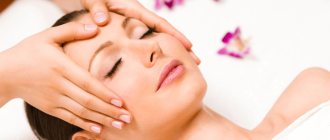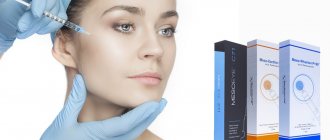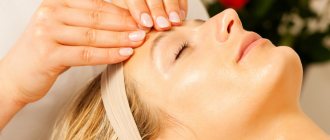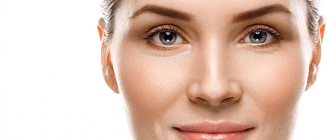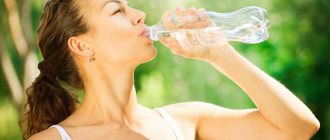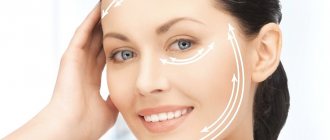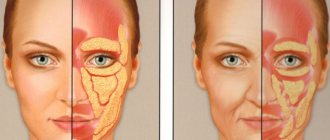The onset of age-related changes in the skin occurs at the age of 25-30. Depending on the degree of care, by the age of 50 the condition of the facial skin noticeably worsens, often requiring radical measures. The natural aging process at this age is exacerbated by menopause, which is followed by hormonal changes in the body. This factor manifests itself most noticeably on the face:
- wrinkles deepen;
- the skin becomes dry and flabby;
- even in the absence of excess weight, a double chin appears.
Facial massage, when performed correctly, can activate internal cellular processes, trigger the mechanism of cell rejuvenation and improve the appearance of the face.
Specifics of facial massage
The most favorable time to perform the procedure is the evening before bed, since after the massage the skin becomes very sensitive and it is not advisable to go outside after the session. If this is not possible, massage at any time, but after the procedure, at least half an hour should pass before applying makeup and leaving the house.
How to prepare your skin for a massage
Before performing a massage, you must first cleanse your facial skin. Even if there is no makeup on, still use lotion - it will wash away the remaining cream and cleanse the skin of secretions and street dust. Most techniques involve manual massage, so wash your hands thoroughly before working with your facial skin.
Before the procedure, the skin should be prepared for comfortable gliding. To do this, you can use vegetable oil (preferably olive) or any fatty cream intended for daily care. You need to apply the product until the skin shines. After 50 years, the skin is very dry and facial massage on insufficiently lubricated skin will be a rather traumatic procedure.
At the end of the procedure, the remaining cream or oil is washed off with warm water.
The duration of the massage depends on the technique used, usually it takes from 10 to 15 minutes. Longer active contact with facial skin is undesirable, as it will cause irritation and pain.
Causes of skin aging and indications for use
The starting point from which the skin undergoes physiological changes is considered to be the age of 25 years. Small errors are possible due to the characteristics of the body and genetic factors.
During this period, metabolic processes slow down. There is less active division of epidermal cells. Moisture evaporates faster due to the thinning of the cell membrane. This leads to a gap in the interval between the death of old collagen fibers and the formation of new ones.
The intensity of the aging process is individual for each woman. For some, signs are noticeable by the age of 30. But usually the result of age-related changes is obvious by 40-50 years.
In the period from 25 years of age to 40-50 years, physiological changes in the epidermis occur slowly. A sharp deterioration in skin condition is observed during menopause, which is facilitated by hormonal surges. This is most noticeable on the face. The situation is aggravated by external factors, which include:
- ultraviolet;
- temperature changes;
- increased evaporation of moisture, etc.
The level of components responsible for moisture retention and muscle elasticity (hyaluronic acid, collagen, polysaccharides, elastin) decreases in the skin composition. Thanks to the development of the beauty industry, it has become possible to saturate the dermis with valuable substances artificially.
High-quality cosmetics for women over 50 are enriched with hyaluronic acid and collagen. With the help of special elements, the production of its own components is stimulated.
Indications for facial massage:
- thinning of tissues;
- deterioration of complexion;
- puffiness, bags under the eyes;
- loss of skin elasticity;
- changing the line of the oval;
- formation of irregularities, stagnation;
- the presence of folds, wrinkles and stretch marks.
Japanese facial massage Asahi
Asahi is a type of lymphatic drainage massage. It tightens the swollen oval of the face well, eliminates stagnation of lymph and fluid in the tissues, as a result of which sagging skin and swelling are reduced.
After 50 years, the Asahi technique focuses on the lower part of the face, since the main problem of this age is sagging cheeks and a sharp recession of the nasolabial folds.
The Japanese massage technique is based on deep kneading of the facial muscles; the effect on the skin should be as deep as possible. Therefore, the procedure itself takes about 3 minutes.
Each exercise should be performed 3 times; for the most problematic areas, you can perform 5-6 repetitions.
How to perform an Asahi facial massage
- Make fists with your thumbs facing inward. Place them on the corners of your lips so that the phalanx of your index finger is perpendicular. With noticeable pressure, move your fists from the lips to the ears, passing along the lower jaw. In the temple area, open your fists and move your palms down to your collarbones. Repeat three times.
- Place your palm on the corners of your lips towards the side of your nose. Move your hands alternately to the inner corner of the eye from bottom to top along the nasolabial fold so that the movement is continuous. Do 3 repetitions, then move your palm along your cheekbone to your temple and down to your collarbone. Place the fingers of the second hand on top for weighting, when one hand goes down to the collarbone, the other smoothes the skin under the chin and also goes out to the collarbone. Repeat the same on the other side.
- Place your palms on your cheeks so that your middle fingers are on the inner corners of your eyes. Smooth your face toward the ears and down toward the collarbone, lifting the skin slightly away from the lower jaw as you move. Do it three times.
All movements are performed slowly with moderate pressure.
Duration of effect
From a deep facial massage you can get both temporary and quite long-lasting effects. If you do it once, the result is increased microcirculation, swelling disappears, and complexion improves. However, this will not give a lasting positive effect. It is necessary to conduct sessions regularly (10–15 per course) with the required frequency.
When planning massage appointments, be sure to take into account age and skin type:
- At 25 years old, your skin and muscles need additional care. You need to do 1 course per year, consisting of 10 sessions.
- At the age of 30 years and older, 2 courses per year (12–15 sessions) are recommended.
- People over 35 years old need to actively care for their skin to maintain its tone. Massage procedures should be carried out 3 times a year (15–20 sessions).
- Facial massage is also useful after 60 years, since the skin at this age needs even more careful care. However, it is worth abandoning deep techniques and giving preference to superficial options.
Facial massage with honey after 50 years
Facial massage with honey stimulates blood circulation, promotes renewal of the epidermis, cleanses the skin and kneads the facial muscles. For the session you will need natural honey in liquid and warm form. If it is sugared, heat it in a water bath. One teaspoon of honey will be enough. If desired, you can add essential oils to it. There is no point in using vegetable oils for this massage. Pre-cleanse the skin of your face and hands with tonic.
Honey should be applied to the face with gentle massage movements. The forehead is treated first, then the cheekbones and cheeks, and finally the chin. Honey is distributed over the face from the center to the temples and ears and rubbed into the skin.
Please note that honey should be rubbed in without applying pressure.
You can finish the massage with light stroking and rinse off the honey with warm water if you have very sensitive skin on your face. However, whenever possible, use the tapping technique. This procedure is very beneficial for the skin. To do this, you can take small pieces of natural fabric, but it is better to do everything with your fingers.
The unique composition of honey starts the process of facial rejuvenation.
After applying honey to your face, touch your fingers to your skin so that they stick to the honey. Tear off your fingers with a moderately sharp movement. Avoid too sudden movements. Repeat the steps for 5 minutes. When finished, rinse off the honey with warm water.
Contraindications
Massage, like any intervention in the functioning of the body, should be carried out only with the permission of a doctor, after identifying all possible contraindications.
For example:
- infectious and viral skin diseases;
- autoimmune diseases;
- inflammation of the skin on the face;
- cardiac pathologies in the acute stage;
- oncological neoplasms;
- blood clotting disorders;
- elevated body temperature, general weakness of the body.
Carrying out highly impactful skin procedures in the presence of at least one of the listed contraindications increases the risk of complications of the underlying disease.
Acupressure facial massage after 50 years
The acupressure technique is based on the impact of fingers on certain points - lymph nodes, for better drainage of this fluid. The necessary points are in the following places:
- whiskey;
- at the wings of the nose;
- under the lower lip in the center;
- near the auricle;
- at the top of the bridge of the nose, between the eyebrows.
Apply moderate pressure to each point with the pads of your thumbs for 7 seconds. In general, the procedure should take about 10 minutes. This technique does not require the use of creams; there is no slipping on the skin.
Myths about massage
Massage stretches facial skin
This myth has no basis, but nevertheless is quite tenacious. Firstly, facial massage is performed along massage lines - the lines of least stretch of the skin. And secondly, our skin is very elastic, and it’s impossible to just stretch it.
Our skin stretches only in one case - when the volume of tissue underneath it increases. For example, if you gain weight, during pregnancy or in case of severe swelling. But as soon as the volume decreases, the skin tends to shrink back under the changed volume.
Of course, over the years, the elasticity of the skin decreases, but even in old age, the skin sags not so much because it has lost elasticity, but because the volume of tissue underneath it has changed significantly - the volume of the skull bones, muscles and subcutaneous fat.
I don’t see any effect from the massage
Sometimes you can hear such reviews. In fact, after a good massage, the effect is felt after the first session.
Anyone who has had the pleasure of enjoying a good massage will certainly confirm this. If there is no effect from the massage, it means either the specialist is weak in the massage technique, or the technique itself is weak and ineffective.
Massage is a procedure where the result very much depends on the qualifications of the specialist, in contrast, for example, to some hardware techniques, where it is relatively easy to master the correct technique for performing the procedure.
For example, some girls now do the same ultrasound peeling (ultrasonic cleaning) at home on their own using a portable ultrasound scrubber and instructions for use.
Facial massage is a useless procedure
This opinion can sometimes be heard from some cosmetologists.
I think, for the most part, this is said by those cosmetologists who either have poor knowledge of massage techniques, or are in poor physical shape and are simply not able to regularly perform such procedures.
After all, massage is hard physical work.
Massage gives only relaxation and nothing more
Even if massage only provided relaxation, for this alone it would become an indispensable procedure these days, when most people suffer from physical and mental stress.
There are even special techniques, for example, neurosedative massage of the face and body, where the effect is aimed primarily at the nervous system.
The purpose of this massage is to eliminate the effects of prolonged stress, because stress has a negative effect on the entire body.
However, as I already said, the effect of massage is not limited to relaxation alone.
Massage is a panacea for all problems
This opinion can sometimes be heard from some massage therapists. In fact, massage is an element of a healthy lifestyle for your face and body, such as exercise.
In other words, this is an important component of care, but not a panacea. There is no panacea at all; to slow down aging and maintain health, an integrated approach is required.
What effect does aging have on the body?
With age, the body changes significantly; the older the person, the more noticeable the changes become. The processes begin to be felt from 60–75 years.
At this time, bones become fragile and joints become inactive. The skin becomes loose, wrinkles form, and a dry, pale appearance appears. Shortness of breath, fatigue, and memory loss occur. The lungs, heart, and nervous system of the elderly are subject to wear and tear, and normal loads are difficult to bear. Muscles become decrepit, lose volume and mass. Diseases that are easily tolerated in youth become protracted, reducing human immunity.
The benefits of visiting for diseases of blood vessels and heart
In older people, the muscle mass of the main organ that pumps blood throughout the body decreases. To compensate for the lack of oxygen, the human heart tries to beat faster. Tachycardia, arrhythmia, and heart failure gradually appear.
During reduced blood flow and atherosclerosis, toxic substances and remnants of the breakdown of biofuel fluid are not removed from the body. Massage improves blood flow to the heart muscle and restores capillary tone. A person feels a surge of strength, good sleep and appetite return.
Which massage to choose
It is necessary to take into account the individual, physiological characteristics of the patient. Provided that you continue to exercise and do daily exercises in the morning, any type of massage is available to an elderly person, including sports and preventive massage.
When a pensioner has joint diseases or problems in the cardiovascular system, sessions of special techniques are recommended. For nursing home residents, light techniques are used that exclude strong kneading; movements must be performed smoothly and easily. It is necessary to take into account the presence of chronic diseases recently suffered by a person.
